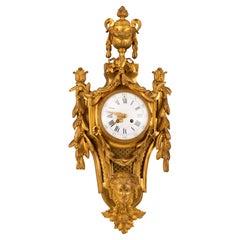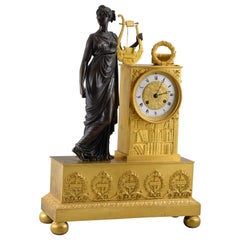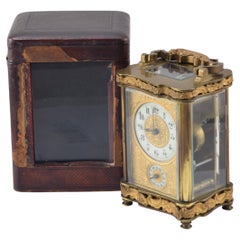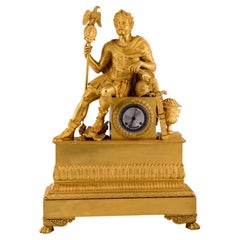Want more images or videos?
Request additional images or videos from the seller
1 of 9
Table clock with bell glass. Wood. bronze, etc. 19th century
$1,675.38List Priceper set
About the Item
- Dimensions:Height: 10.63 in (27 cm)Width: 15.75 in (40 cm)Depth: 7.88 in (20 cm)
- Sold As:Set of 2
- Style:Neoclassical Revival (Of the Period)
- Materials and Techniques:
- Place of Origin:
- Period:
- Date of Manufacture:19th century
- Condition:Wear consistent with age and use. Minor losses. Minor fading.
- Seller Location:Madrid, ES
- Reference Number:Seller: zf09411stDibs: LU2951329777582
About the Seller
4.9
Vetted Professional Seller
Every seller passes strict standards for authenticity and reliability
Established in 1985
1stDibs seller since 2017
350 sales on 1stDibs
Typical response time: 17 hours
Authenticity Guarantee
In the unlikely event there’s an issue with an item’s authenticity, contact us within 1 year for a full refund. DetailsMoney-Back Guarantee
If your item is not as described, is damaged in transit, or does not arrive, contact us within 7 days for a full refund. Details24-Hour Cancellation
You have a 24-hour grace period in which to reconsider your purchase, with no questions asked.Vetted Professional Sellers
Our world-class sellers must adhere to strict standards for service and quality, maintaining the integrity of our listings.Price-Match Guarantee
If you find that a seller listed the same item for a lower price elsewhere, we’ll match it.Trusted Global Delivery
Our best-in-class carrier network provides specialized shipping options worldwide, including custom delivery.You May Also Like
Gilt Bronze and Wood Table Clock, France, Late 19th Century
By Ecole Boulle
Located in Buenos Aires, Buenos Aires
Gilt bronze and wood table clock, France, late 19th century.
Category
Antique Late 19th Century French Louis XV Table Clocks and Desk Clocks
Materials
Bronze
19th Century Onyx and Bronze Clock with William Shakespeare
Located in Hoddesdon, GB
A William Shakespeare Gothic revival mantle clock, dating back to the mid-19th century, superb quality and is made from onyx and gilt bronze. The clock showcases reeded column suppor...
Category
Antique Mid-19th Century French Gothic Revival Mantel Clocks
Materials
Onyx, Bronze
EARLY 19th CENTURY INLAID CLOCK WITH BRONZES
Located in Firenze, FI
Splendid walnut wood clock, finely carved and enriched with fruit wood inlays featuring plant motifs. These details give further elegance to the clock, visible both on the front and ...
Category
Antique Early 19th Century French Table Clocks and Desk Clocks
Materials
Bronze
Gilt Bronze Cherub Table Clock 19th century
Located in Staffordshire, GB
19th century Louis XV1 Style Cherub Mantle Clock with white porcelain dial, platform escapement in circular bleu du roi decorated case, held aloft by gilt cherub on alabaster base.
...
Category
Antique 19th Century French Louis XVI Table Clocks and Desk Clocks
Materials
Bronze
Ebonized Wood Clock, 19th Century
Located in Roma, IT
Ebonized Wood Clock is a decorative object realized in the 19th century.
Ebony and metal.
Good conditions, though some flaws are present.
Fine and ancient clock...
Category
Antique 19th Century Italian Table Clocks and Desk Clocks
Materials
Metal
Clock With Warrior Helmet, Bronze, 19th Century
Located in MARSEILLE, FR
Bronze clock with double patina, gold and brown, topped with warrior attributes: sword, helmet richly decorated with feathers and a chimera or dragon's head, Pegasus and a face, and ...
Category
Antique 19th Century French Restauration Mantel Clocks
Materials
Bronze
19th Century Egyptian Revival Bronze Mantel Clock
Located in New York, NY
Antique (late 19th century) Egyptian Revival period French empire style mantel clock in bronze with dark brown patina, retailed at Brown and Rogers of Providence, Rhode Island.
Category
Antique Late 19th Century French Egyptian Revival Mantel Clocks
Materials
Bronze
Elegant 19th Century Bronze Clock Empire
Located in Madrid, ES
Elegant 19th century bronze clock.
19th Century French clock in gilded bronze. The machinery works and has its pendulum and key. Difficult ...
Category
Antique 19th Century French Empire Table Clocks and Desk Clocks
Materials
Bronze
Gilt bronze clock, 19th century
Located in Saint-Ouen, FR
Gilt bronze clock, 19th century
Large original gilt bronze clock, decorated with garlands of flowers and two hull heads to the right and left of the...
Category
Antique 1860s European Napoleon III Wall Clocks
Materials
Bronze
19th Century Gilt Bronze Clock.
Located in Saint-Ouen, FR
19th century gilt bronze clock.
A gilt bronze clock from the 19th century, Napoleon III period, clock movement to be overhauled.
H: 51cm, W: 37cm, D: 12cm
Category
Antique 19th Century French Napoleon III Table Clocks and Desk Clocks
Materials
Bronze
More From This Seller
View AllWall clock. Gilt bronze. France, 19th century.
Located in Madrid, ES
Wall clock. Gilt bronze. France, 19th century.
Gilt bronze wall clock of the type known as a "cartel" due to its shape, featuring Parisian movement and a white dial with Roman numer...
Category
Antique 19th Century French Neoclassical Revival Wall Clocks
Materials
Bronze, Other
Table clock with Muse and writers. Bronze, Paris movement. France, 19th century.
Located in Madrid, ES
Table clock with Muse and writers. Blued and gilded bronze, Paris movement. France, 19th century.
Perfectly working mechanism.
Table clock in blued and gilt bronze with Paris mac...
Category
Antique 19th Century French Neoclassical Revival Mantel Clocks
Materials
Bronze, Other
Carriage clock with case. 19th century
Located in Madrid, ES
Travel clock with case. Metal, glass, leather, etc. XIX century.
Case with lid at the top and front with a transparent glass sheet, upholstered on the inside, containing a travel cl...
Category
Antique 19th Century European Neoclassical Revival Carriage Clocks and T...
Materials
Metal, Other
Table clock, Aníbal Barca. Ormolu bronze, metal. France, 19th century.
Located in Madrid, ES
Table clock, Aníbal Barca. Ormolu bronze, metal. France, 19th century.
Table clock with Paris machinery and a case made of mercury-gilded bronze. in mercury-gilded bronze, with a rectangular base on four rectangular base on four legs (the front ones decorated with scrolls and decorated with scrolls and ending in claws), decorated with a series of mouldings in relief with vegetal and architectural elements. vegetal and architectural elements in relief. The dial The dial (metal with Roman numerals for the hours) is set within a square shape, on which sits the male figure that decorates the piece. A bearded man, dressed in armour (a muscular loriga or cuirass) and a cape fixed over one shoulder with a fibula, resting his left arm on the helmet holding a rolled-up document, and with his left hand document, and with his left hand he holds a Roman standard (another Roman standard (another is broken, under his foot). Note, to the right and next to a sword, a vase full of rings.
vase full of rings.
Hannibal Barca (247-183 BC) was a Carthaginian general and statesman who was well known for his Carthaginian general and statesman, well known for his the ancient Roman Empire. No He was often depicted as counting the rings of fallen Roman knights in
the fallen Roman knights at the battle of Cannas (216 BC). , as can be seen in the sculpture by
sculpture by Sébastien Slodtz (made in 1704, Louvre Museum, Paris), where he also carries a Roman banner. Roman standard. With these two elements (vase with rings and with rings and a banner) is also shown on a table clock...
Category
Antique 19th Century European Neoclassical Revival Mantel Clocks
Materials
Bronze, Other
Garniture, clock and candelabra. Bronze, porcelain. France, 19th century.
Located in Madrid, ES
Garnish with clock and candelabra in porcelain and gilt bronze. France, 19th century.
Mechanism in perfect working order.
Fireplace garnish composed of a clock and two five-light candelabras, all three pieces made by combining gilt bronze, with relief elements and round bulges and cold-chiseled details, and porcelain decorated with low-temperature enamels, including gold enamel. The porcelain pieces follow models from the Sèvres National Manufacture of the 18th century, with large pictorial cartouches on a cobalt blue background adorned with golden plant motifs. The set follows a historicist design that combines baroque and neoclassical elements with enamelled scenes of Rococo inspiration, representing landscapes and scenes with mythological themes alluding to the arts and the goddess Venus. The clockwork is stamped “Chles. MT”, with serial number 17420. The main glazed porcelain plates are signed DP Boncher. The clock follows an architectural structure, with an oval base with a prominent front in plan, raised on four molded feet in the shape of a top, on which a large ornamental vase is placed. This plinth has a distinct pinto and, above it, a main body as a façade, with a circular pediment that houses the clock face. This includes black enamelled Roman numerals on white medallions with a gold border, arranged around the central representation of a putti reclining among clouds, holding a floral garland and accompanied by musical instruments. Among the medallions that house the numbers, a small jeweled decoration that evokes pearls and embedded rubies, which is echoed in the secondary areas of the body of the piece and also the vase, always combined with delicate golden filigrees.
On both sides of the sphere are two female portraits of ladies from the 18th century, in oval frames. Below, a classically inspired scene with a muse holding musical instruments, probably Euterpe or Erató, accompanied by a putti reading a sheet of music. On the sides of the clock body, two large curved rectangular plates house highly pictorial enameled landscapes, worked with the same miniaturist precision as the rest of the enameled cartouches. These are landscapes of romantic heritage, again inspired by the 18th century, with ideal settings for a twilight atmosphere, featuring classical ruins. The vase that tops the body of the clock has a hemispherical tank, shoulders ending in an edge, an openwork truncated conical neck, which opens smoothly towards the shoulders, and a domed lid, also openwork. The handles are figurative, in bronze, with two female sisters crowned with flowers, of clear Greco-Latin inspiration, worked in a round shape. In the tank, the vase houses two enameled porcelain cartouches, the front one with two putti and a dove - a symbolic allusion to Venus - and the back one with musical instruments. The design of the clock is completed by two thick bronze S-shaped plant braces, under the vase, and counter moldings and plant motifs cast in relief and cold chiseled, combining matte and polished finishes. The candelabras follow a similar design, with large vases of neoclassical design on pedestals, in this case cylindrical, raised on four low feet of turned design. The bases house porcelain cartouches with scenes of putti related to the arts; In one of them we see two putti practicing painting, and in the other two others in a scene related to classical lyric poetry, with one putto writing while the other, holding a lyre, raises a laurel wreath above his head. The cartouches that occupy the front of the candelabra vases...
Category
Antique 19th Century French Neoclassical Revival Mantel Clocks
Materials
Metal, Bronze, Other
Clock Set, Bronze, Rouge Griotte, Etc, France, 19th C. After Clodion
Located in Madrid, ES
Clock garnish and two candlesticks. Bronze, rouge griotte marble. France, 19th century, following Clodion's models.
Set or garnish consisting of a table clock and two candlesticks ...
Category
Antique 19th Century French Neoclassical Table Clocks and Desk Clocks
Materials
Griotte Marble, Bronze, Other
Recently Viewed
View AllMore Ways To Browse
Antique Table Bell
Glass Bell 19th Century
Lantern Clock
Antique Lantern Clocks
Antique Clock Other Antique Clocks
Antique Marble Clocks Black
Antique Pineapple Finial
Black Antique Clocks
Louis Xv Style Clocks
Gilded Bronze Clocks
French Clocks With Silk Suspension
Black Mantel Clock French
French Gilt Rococo Mantel Clock
Unusual Clock
French Gilded Antique Clocks
Green Clock
Cherub Clock
Hes Clock



